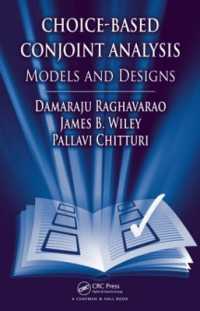Full Description
Why does food taste better when you know where it comes from? Because history-ecological, cultural, even personal-flavors every bite we eat. Whether it's the volatile chemical compounds that a plant absorbs from the soil or the stories and memories of places that are evoked by taste, layers of flavor await those willing to delve into the roots of real food. In this landmark book, Gary Paul Nabhan takes us on a personal trip into the southwestern borderlands to discover the terroir-the "taste of the place"-that makes this desert so delicious.
To savor the terroir of the borderlands, Nabhan presents a cornucopia of local foods-Mexican oregano, mesquite-flour tortillas, grass-fed beef, the popular Mexican dessert capirotada, and corvina (croaker or drum fish) among them-as well as food experiences that range from the foraging of Cabeza de Vaca and his shipwrecked companions to a modern-day camping expedition on the Rio Grande. Nabhan explores everything from the biochemical agents that create taste in these foods to their history and dispersion around the world. Through his field adventures and humorous stories, we learn why Mexican oregano is most potent when gathered at the most arid margins of its range-and why foods found in the remote regions of the borderlands have surprising connections to foods found by his ancestors in the deserts of the Mediterranean and the Middle East. By the end of his movable feast, Nabhan convinces us that the roots of this fascinating terroir must be anchored in our imaginations as well as in our shifting soils.
Contents
Preface
Chapter 1: Introduction to Organics
Reasons to Go Organic
Converting to the Natural Organic Program
Chapter 2: Soil Building
Basic Soil Science
Soil Biology
Soil Texture
Nutrients
Soil Testing
Soil Amendments
Chapter 3: Planting
Basic Bed Preparation
Seed Planting
Cuttings
Transplants
Tree Planting
Potting Soil
Chapter 4: Fertilizing
How Organic Fertilizers Work
Foliar Feeding
Product Information
Refractometer
Chapter 5: Pest and Disease Control
The Real Purpose of Toxic Chemical Pesticides
Pests and Their Organic Remedies
Insect Pests
Structural Pest Control
Honeybees and Other Pollinators
Diseases
Weeds: The Disliked Plants
Chapter 6: Compost
Why Compost?
Compost Types and Methods
Compostable Materials
Composting Process
Warning Signs in Compost
Vermicomposting
Using Compost
Compost Tea
Chapter 7: Mulch
Mulch Types
Mulch Uses and Applications
Pitfalls of Mulching
The Science of Mulch
The Mulch Business
Mulches Not Recommended
Chapter 8: Landscaping
Landscaping Elements
Landscaping Specifications
Chapter 9: Commercial Growing Operations and Recreational
Properties
Commercial Growing Operations
Recreational Properties
Chapter 10: Organic Strategies and Global Climate Change
Global Warming by the Numbers
Organic Methods Make a Difference
The Link to Soil Life
Carbon-rich Organic Glue
Organic Material, Organic Matter, and Soil Carbon
Squashing the Symbiosis
Managing Trees in Landscapes as Carbon Sinks
Landscape and Turf Management
Conclusions
Appendix 1: Organic Treatment Formulas
Appendix 2: Sources for Organic Supplies
Appendix 3: Soil-Testing Resources
Appendix 4: Conversion Tables
Information Resources
Index







